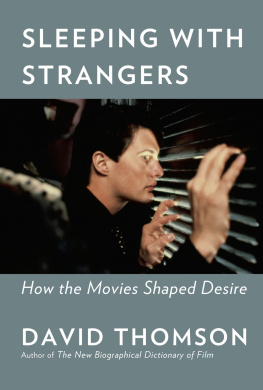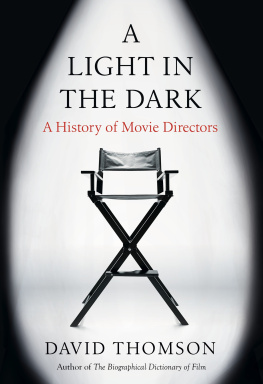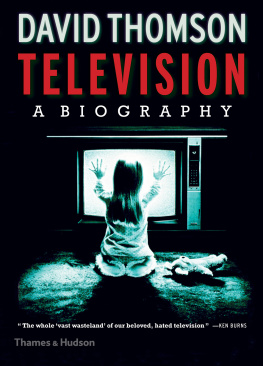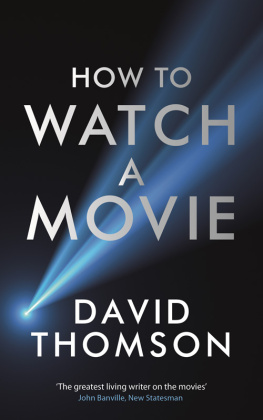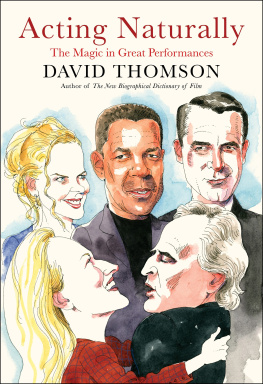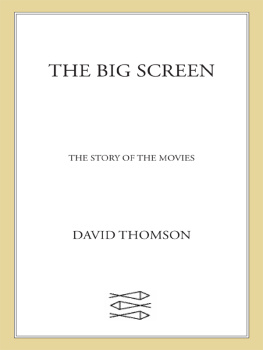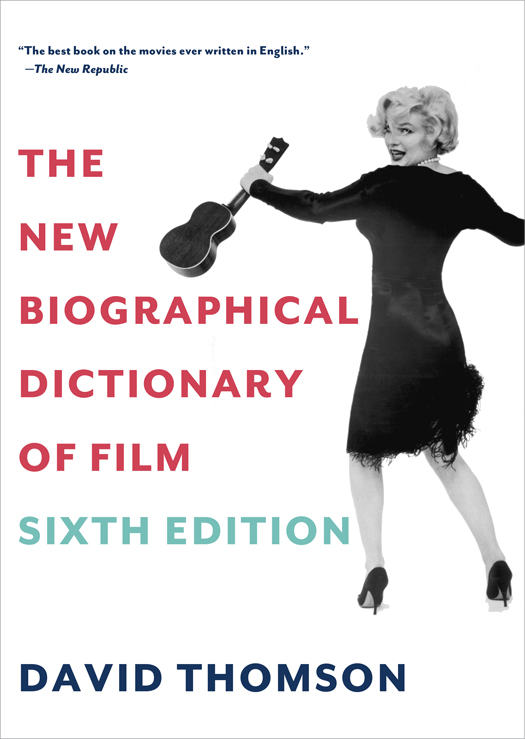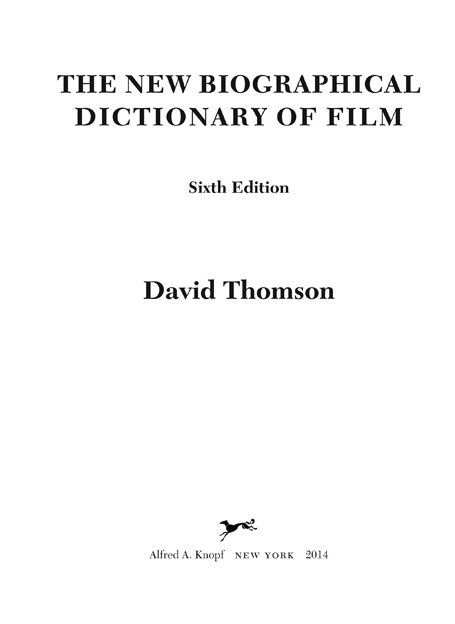THIS IS A BORZOI BOOK
PUBLISHED BY ALFRED A. KNOPF
Copyright 1975, 1980, 1994, 2002, 2004, 2010, 2014 by David Thomson
All rights reserved. Published in the United States by Alfred A. Knopf, a division of Random House LLC, New York, and in Canada by Random House of Canada Limited, Toronto, Penguin Random House companies.
www.aaknopf.com
First and second editions of this work published in the United States by William Morrow and Company, Inc., New York, in 1976 and 1981. All subsequent editions published in the United States by Alfred A. Knopf, a division of Random House LLC, New York, in 1994, 2002, 2004, and 2010.
Knopf, Borzoi Books, and the colophon are registered trademarks of Random House LLC.
Library of Congress Cataloging-in-Publication Data
Thomson, David, [date]
The new biographical dictionary of film/by David Thomson.6th ed.
p. cm.
A Borzoi book.
ISBN 978-0-375-71184-8
1. Motion picture actors and actressesBiographyDictionaries. 2. Motion picturesBiographyDictionaries. I. Title. II. Title: Biographical dictionary of film. III. Title: Dictionary of film.
PN1998.2.T49 2010
791.43028092273dc22 2010016450
eBook ISBN: 978-1-101-87470-7
Trade Paperback ISBN: 978-0-375-71184-8
Cover image: Some Like It Hot 1959 Metro-Goldwyn-Mayer Studios, Inc.
All Rights Reserved. Courtesy of MGM Media Licensing. Photo by Hulton
Archive / Moviepix /Getty Images
Designed by Virginia Tan
Jacket design by Carol Devine Carson
First American Edition, 1976
Second American Edition, 1981
Third American Edition, 1994
Fourth American Edition, 2002
Paperback, Revised and Expanded, 2004
Fifth American Edition Published October 26, 2010
Sixth Edition, Paperback, Published May 8, 2014
v3.1
For Kate and Kieran
The year before, I had been to the cinema for the first time and seen a film about a horse. I think it was called Black Beauty and was based on a famous book. The film was on at the Sture cinema and we sat in the front row of the circle. To me, it was the beginning. I was overcome with a fever that has never left me. The silent shadows turned their pale faces towards me and spoke in inaudible voices to my most secret feelings. Sixty years have gone by and nothing has changed; the fever is the same.
Ingmar Bergman, The Magic Lantern
The great trouble is people trying to be funny. If they dont try to be funny, then they are funny.
Howard Hawks, talking about Katharine Hepburn and Bringing Up Baby, in Hawks on Hawks
Contents
INTRODUCTION
On January 3, 2014, as I was reading the proofs for this sixth edition of the Biographical Dictionary of Film, and wondering what to say in an introduction, news came from London that Tom Rosenthal had died. No one did more for this book than he had done. But in addition, his passing led me to reflect on the history of the book and its uncertain status now that it is six.
The book was conceived in 1971, by Secker & Warburg, as a modest encyclopedia on film. James Price had been the commissioning editor, and the proposal called for a book that would cover technical terms, national cinemas, and business events, as well as the leading figures in cinema history. Cinema was the word we used then, and the plan was for an age in which cinema, film, and movie had as yet made small inroads on academia. Furthermore, although the early seventies was a very exciting time in film (The Godfather, The Conformist, The Discreet Charm of the Bourgeoisie, Fassbinder rampant, Cline and Julie Go Boating), people watched movies in very much the ways that had existed for six decades. We turned up at a movie theatre at the appointed time and we saw a large projected image in a band of strangers. In hindsight, I think the communal experiencethe collective shockof Taxi Driver, Jaws, and One Flew Over the Cuckoos Nest was close to the end of a technology. It was a heady time to be writing what turned out as this book.
Well, James Price moved on, as editors often do, so I found myself in the position, by 1973, of having an unfinished book that was already far longer than it should have been, and that only dealt with the careers of peopledirectors, actors, producers. I knew I was going off contract and toward half a million words, and I thought it prudent to show what I had done to Seckers if only to discover the finality of their bewilderment or wrath. The new man at the house was Tom Rosenthal. I went in to see him and I delivered the work-in-progress. He listened to my incoherent explanation of why I had not followed orders and he said he would read. So he did, and when we met again, in his most splendid and grave way he agreed that it was not the book that had been undertaken, that it was growing into some kind of monster, the fate of which he could not predict, but he felt it was arresting and passionate, and he said I should proceed.
The book was becoming a collection of short essays on filmmakers and it was composed in the spirit of my own movie education. I was English, and I had grown up in mounting contempt for the official English attitudes toward film history and had become more and more devoted to the ideas put forward in French film magazines, notably Cahiers du Cinma and Positif. They liked the films I liked, and more or less for the reasons I approved of, the largest of which was to say that film, or cinema, was not a mere adaptation of literature and theatre but was a reckless new form (attuned to mass society) that occurred on screens in the dark, and had to do with desire, fantasy, danger, and impossibility. A feeling lingered that movies might be bad for us, as well as transformingand I hope that feeling never goes away.
I wrote the Dictionary to stand upin Englishfor that new tradition. This meant that I admired Nicholas Ray more than I did David Lean; that I felt the most important actors in film history were Cary Grant, Robert Mitchum, and Barbara Stanwyck; and so on. Such claims are closer to orthodox now, but they disturbed plenty of people in 1975 when the book was first published. (Indeed, I discovered that both Grant and Mitchum were taken aback.)
So I was offering an interpretation of film history, and it has been a great upheaval in renewing the book because so much has changed since 1975. This book was written first without a computer, databases, or the resources of video. It grew out of lists made in the library of the British Film Institute, a practice I pursued with my friend Kieran Hickey, to whom the book has always been dedicated, because it developed out of conversations with him. Its other inspiration was seeing almost everything the National Film Theatre showed, along with the London repertory theatres that still existed in the 1960s, and the pictures that began to be shown on television.
Today, there may be enthusiastic readers of this book who have seen very few movies on 35mm, in a large theatre, with a big crowd. The shifts in technology are not simply a neutral alteration in the means of looking. The change has persuaded me that the project of looking at film always failed to grasp how much we were caught up in the process of looking at screens. We thought we were looking at the imprint of life and story, when we were also studying a mechanism that separated us from those things. In the second and third and fourth and fifth editions of this book I did my best to acknowledge how far television was not a vulgar rival to movies but an organic development of it. So a large entry on Johnny Carson appeared, to the extent that I felt he was every bit as important as Cary Grantyet far more pervasive. By now, the small screens have diversified in so many ways. This sixth edition admires people like Bryan Cranston and Elisabeth Moss (from



